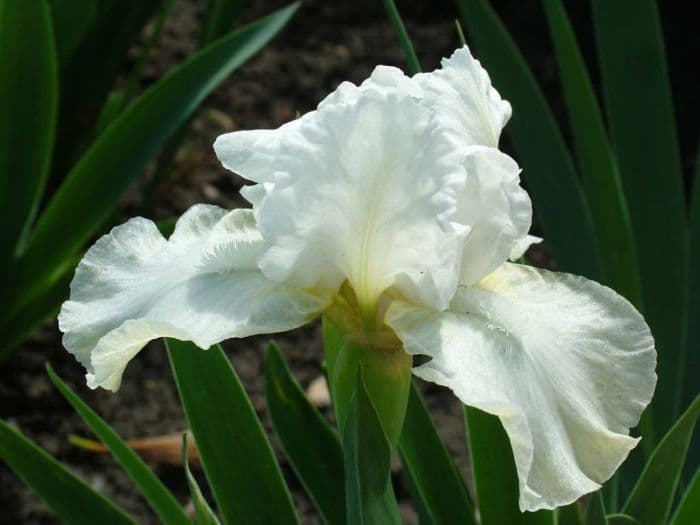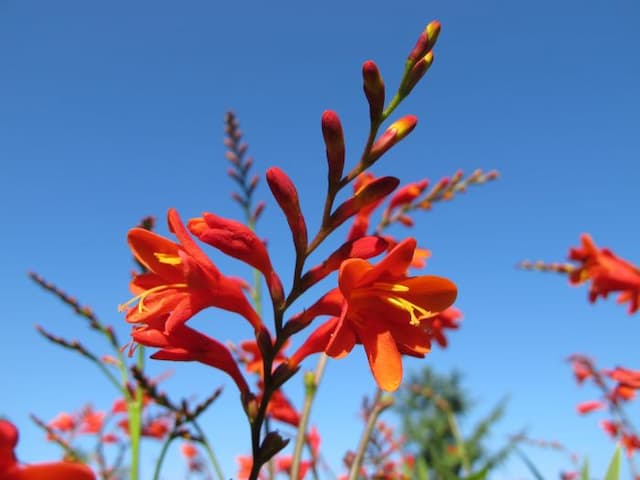Dwarf Iris Iris 'Zero' (SDB)

ABOUT
The Iris 'Zero' (SDB), also known as the Standard Dwarf Bearded Iris, boasts a striking appearance that makes it a standout in any garden. Its petals display a beautiful range of colors, typically featuring vibrant hues that can include shades of blue, purple, yellow, or white, among others. This variety of iris has a unique pattern of color distribution, with the standards (upright petals) sometimes showing a lighter or different shade compared to the falls (downward petals). The falls may be adorned with intricate veining or speckles that add to the visual interest of the flower. At the base of the falls, there's often a distinct area called the beard, which usually presents a contrasting color and has a soft, fuzzy texture. The foliage of the Iris 'Zero' is made up of long, slender, sword-shaped leaves that create an attractive, grass-like clump, providing a lush green backdrop that further accentuates the beauty of the blooms. The overall effect of these features is a delightful, eye-catching plant that brings elegance and charm to the setting in which it is planted.
About this plant
 Names
NamesFamily
Iridaceae.
Synonyms
Standard Dwarf Bearded Iris, SDB Iris.
Common names
Iris 'Zero' (SDB)
 Toxicity
ToxicityTo humans
The Dwarf Bearded Iris, commonly known as Iris 'Zero', contains compounds that can be toxic if ingested. Although it's known more for its ornamental qualities than for being a hazardous plant, all parts of the Iris, especially the rhizomes and bulbs, contain irritants in the form of glycosides. If ingested, these can cause symptoms such as nausea, stomach pain, vomiting, and diarrhea. It is important to handle this plant with care to avoid skin irritation, and ingestion should be strictly avoided.
To pets
The Dwarf Bearded Iris, known simply as Iris, can be toxic to pets if ingested. All parts of the plant, but particularly the rhizomes and bulbs, contain irritants. Consumption of these parts can lead to gastrointestinal symptoms in pets, such as drooling, loss of appetite, vomiting, and diarrhea. In severe cases, ingestion can result in lethargy or more serious gastrointestinal issues. Keep pets away from Iris plants to prevent accidental ingestion and potential toxicity.
 Characteristics
CharacteristicsLife cycle
Perennials
Foliage type
Deciduous
Color of leaves
Varies
Flower color
Mixed
Height
1 foot (0.3 meters)
Spread
1 foot (0.3 meters)
Plant type
Bulb
Hardiness zones
4
Native area
Temperate Northern Hemisphere
Benefits
 General Benefits
General Benefits- Attractive Blooms: Iris 'Zero' features showy flowers that add aesthetic appeal to gardens and landscapes.
- Compact Size: Being a Standard Dwarf Bearded (SDB) Iris, it is suitable for smaller gardens or spaces where a compact plant is desired.
- Drought Tolerance: Once established, these irises are relatively drought-tolerant, making them suitable for xeriscaping or low-water conditions.
- Easy to Grow: Iris 'Zero' is known for being easy to culture, requiring minimal maintenance and care to thrive.
- Versatility: This plant can be used in a variety of garden settings, including borders, rock gardens, and as a clumping feature in mixed beds.
- Pollinator Friendly: The blooms of the Iris 'Zero' attract bees and other pollinators, supporting local ecosystems.
- Deer Resistant: Irises are generally resistant to deer, making them a good choice in areas where deer browsing is a problem.
- Seasonal Interest: Irises provide early to mid-spring blooms, offering color and visual interest after the end of winter.
- Propagation: Irises can be easily propagated through division, allowing gardeners to expand their collection without additional cost.
 Medical Properties
Medical PropertiesThis plant is not used for medical purposes.
 Air-purifying Qualities
Air-purifying QualitiesThis plant is not specifically known for air purifying qualities.
 Other Uses
Other Uses- The rhizomes of the Iris can be dried and carved into small talismans or decorations, owing to their firm, woody texture once desiccated.
- Dye can be extracted from the flowers of the Iris, providing a natural coloring agent for textiles, art, or even food.
- Fibers from Iris leaves can be twisted or braided to create strong natural cords or ropes for garden use or small handiwork projects.
- The plant can be used as a tool in teaching botany or horticulture, as it offers lessons in plant structure, growth habits, and breeding.
- Pressed flowers of the Iris can be used in an artform, creating bookmarks, cards, or other decorative paper products.
- Large-scale Iris plantings can deter soil erosion with their robust root system, making them useful for slope stabilization and watershed management.
- The natural form and striking appearance of Irises are often used as inspiration or motifs in design, from architecture to fashion.
- Decomposed parts of the Iris plant can be composted to add valuable organic matter and nutrients back into the garden soil.
- Iris flowers can be used as a natural pH indicator; when used in an infusion, they may change color depending on the acidity or alkalinity of the solution.
- Insect attracting properties of the Iris can be employed as a method to enhance biodiversity in gardens, providing a habitat for beneficial insects.
Interesting Facts
 Feng Shui
Feng ShuiThe Iris is not used in Feng Shui practice.
 Zodiac Sign Compitability
Zodiac Sign CompitabilityThe Iris is not used in astrology practice.
 Plant Symbolism
Plant Symbolism- Faith: The iris is commonly associated with faith, trust, and wisdom. This symbolism is deeply rooted in ancient Greek mythology where Iris was the name of the goddess of the rainbow and a messenger of the gods.
- Hope: Irises are often seen to symbolize hope, reflective of its wide range of vibrant colors and early spring blooming that signify the coming of good times.
- Courage: The flower also embodies courage as it can grow in a variety of conditions and is often seen in early spring, pushing through the last of winter's grasp.
- Wisdom: Irises convey a message of wisdom and intelligence, admired not only for their beauty but also for their complex structure, which can symbolize a deeper understanding.
- Royalty: The elegance of the iris often leads to its association with royalty and regal bearings, it has historically been linked to French kings, and the 'fleur-de-lis' is famously said to represent the flower.
 Water
WaterDwarf Bearded Iris, commonly known as Iris 'Zero', prefers moderate watering, ensuring the soil is kept evenly moist but not waterlogged. During the active growth period in spring and early summer, water approximately once a week with about one gallon of water per plant to support healthy growth. After blooming, reduce watering frequency to discourage rot, providing water only when the top couple of inches of soil become dry. During the winter dormancy, minimal watering is necessary, especially in climates where rainfall provides sufficient moisture.
 Light
LightDwarf Bearded Iris thrives in full sunlight conditions, requiring at least six hours of direct sunlight each day. The best spot for this plant is in an open garden bed unobstructed by trees or buildings where it can receive ample morning light and well-ventilated air circulation, promoting healthy growth and vibrant blooms.
 Temperature
TemperatureDwarf Bearded Iris is cold hardy and prefers temperate climates. It can typically withstand minimum winter temperatures of around 5 degrees Fahrenheit and maximum summer temperatures of 90 degrees Fahrenheit. The ideal temperature range for vigorous growth and blooming is between 55 and 75 degrees Fahrenheit.
 Pruning
PruningPruning Dwarf Bearded Iris involves removing spent flower stalks after blooming and trimming away any damaged or diseased foliage to promote good air circulation and prevent rot. In late summer or early fall, cut the foliage back to about 6 inches above the ground to prepare the plant for winter. Prune annually to maintain plant health and vitality.
 Cleaning
CleaningAs needed
 Soil
SoilDwarf Bearded Iris 'Zero' thrives in well-draining, loamy soil with a slightly acidic to neutral pH of 6.5 to 7.0. Amend soil with organic matter to improve drainage and aeration. Avoid heavy, wet soils to prevent rhizome rot.
 Repotting
RepottingDwarf Bearded Iris 'Zero' does not need frequent repotting and is typically divided every 3-4 years. Repot to manage crowding and rejuvenate the plant for better blooms.
 Humidity & Misting
Humidity & MistingDwarf Bearded Iris 'Zero' is tolerant of a wide range of humidity levels, but it prefers drier conditions and adequate air circulation to prevent disease.
 Suitable locations
Suitable locationsIndoor
Place Dwarf Bearded Iris 'Zero' in a sunny spot, with cool air and drier soil.
Outdoor
Grow in full sun, well-draining soil, and divide clumps every few years.
Hardiness zone
3-9 USDA
 Life cycle
Life cycleThe dwarf bearded iris 'Zero', like all irises, begins its life as a seed, which will germinate when exposed to the proper conditions of moisture and temperature. After germination, the seedling develops into a young plant, producing leaves and establishing a root system. As the iris matures, it enters a vegetative stage where it grows actively, typically characterized by the formation of sword-like leaves and thick rhizomes underground. Upon reaching maturity, the dwarf bearded iris 'Zero' produces flower stalks each spring, blooming with distinctive white flowers that exhibit the species' characterized bearded segments on the fall petals. After pollination and flower wilt, the plant sets seed, which can be dispersed to create new plants, thus continuing the life cycle. Lastly, the dwarf bearded iris enters a period of dormancy during colder months, conserving energy for the next growth cycle.
 Propogation
PropogationPropogation time
Late summer
Propogation: The most popular method of propagating Iris 'Zero', which is a type of Standard Dwarf Bearded Iris (SDB), is through division. This process is typically done in late summer after the flowering has ended, which is an ideal time because the plant has ample time to establish itself before the onset of winter. To propagate through division, the gardener should carefully dig up the iris clump and gently separate the rhizomes with hands or a knife, ensuring that each division has at least one fan of leaves and a portion of the rhizome. The rhizome should be trimmed to about 4 to 6 inches (about 10 to 15 centimeters) to encourage new growth. The divisions are then replanted at the same depth they were growing previously, spaced about 12 to 24 inches (approximately 30 to 61 centimeters) apart to allow for adequate growth and air circulation.









